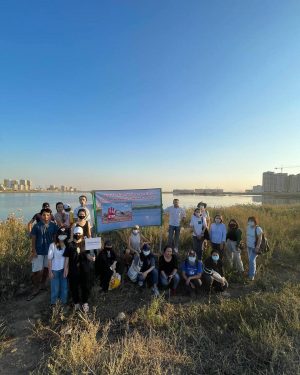In March 2021, a flock of birds carved from ice and snow descended on a square in central Nur-Sultan. These birds, part of an art installation organized by activists affiliated with the group Artcom Platform, eventually melted. The artist-activists had sought to draw attention to the fate of Malyi Taldykol, a reservoir on the edge of Kazakhstan’s capital that is at risk of being drained to make room for ever-expanding construction projects.
Artcom Platform’s work covers a wide range of topics, but another civic initiative has emerged specifically for Malyi Taldykol. Since August 2020, SOS Taldykol – made up of about 150 activists, artists, and scientists – has worked to preserve the reservoir.
In spite of restrictions on civil society and the freedom of association, SOS Taldykol has managed to organize Nur-Sultan residents to defend the reservoir. They have done so by bridging digital media and in-person events. They post frequently on Instagram and Facebook, updating followers on events, which include walks around the lake, birdwatching outings, yoga sessions, and ice skating, as well as Zoom discussions with scientists who have researched the reservoir’s ecosystem and community clean-ups of the lake’s coast.
SOS Tayldykol has also tried to engage with government officials. They have drawn attention to inconsistencies in the authorities’ messaging around the fate of Malyi Taldykol. Local government has been talking in circles around the reservoir for months; Nur-Sultan’s akim asserted that the reservoir would not be drained, but other officials have called for the lake to be drained in order to improve the water quality for public health purposes.
Given the government’s confusing response – and evidence of construction machinery digging around Malyi Taldykol – SOS Talydkol has worked to translate their grassroots community-building into formal political pressure to protect the reservoir. Their Instagram page offers templates for letters to government officials, a link to a digital petition that has gathered nearly 5,000 signatures, and frequent updates on the status of a working group they pushed the government to create.
This triangulated approach to community-building and collective action through art resembles other recent civic initiatives in Kazakhstan. The importance of aesthetics speaks to the deep links between artistic and activist communities in Kazakhstan. Activists do crucial work bridging science, everyday life, and high politics in Kazakhstan, including Saule Suleimenova’s series using plastic bags to depict national trauma stemming from colonialism and Pasha Cas’ mural about the effects of nuclear testing in Semipalatinsk.
Another one of Cas’ pieces, a collaged landscape placed on a stump in Almaty, critiqued the worsening air pollution in Almaty. Cas linked the work to the proposed construction of a ski resort in Kok-Zhailau, a richly-forested area in a national park outside of Almaty. Activists had worked since 2011 on a campaign to save Kok-Zhailau, and their efforts present an interesting parallel for thinking about Nur-Sultan activists’ prospects for preserving Malyi Taldykol.
In October 2019, President Kassym-Jomart Tokayev, who had been president for only a few months, announced a ban on constructing of a resort in Kok-Zhailau. “We don’t need it,” he said. “Moreover, professional environmental engineers and the knowledgeable community are against it.” This knowledgeable community included scientists, writers, engineers, journalists, artists, and activists who worked for almost a decade in defense of Kok-Zhailau. In addition to public demonstrations and a petition that gathered almost 30,000 signatures, those involved with the Save Kok-Zhailau campaign leveraged Kazakhstan’s ratification of international treaties to achieve their goals.
It was ultimately Kazakhstan’s participation in the Aarhus Convention, a treaty that aims to enhance public access to information about the environment, that turned the tides. Activists submitted a complaint to the Aarhus Convention’s Compliance Committee, which in turn found that authorities had failed to solicit sufficient public participation in the decision-making process around felling forests in Kok-Zhailau to build a ski resort.
SOS Taldykol’s formal political engagement – through coaching citizens on submitting petitions to authorities, advocating for a working group, and documenting communication with local officials – creates a paper trail that could make it possible to stop any draining or construction that would threaten Malyi Taldkol. While authorities’ quick assent to establish a working group gives off an aura of interest in public support, SOS Taldykol has carefully documented the group’s activities and found they have met only once in three months since it was founded this spring.
It may seem anti-climactic for these sorts of wins to stem from technicalities. If anything, though, civil society groups’ awareness of how to trigger these technicalities – and, so far, Kazakhstani authorities’ respect for them – suggests a productive model for advocacy moving forward.
































